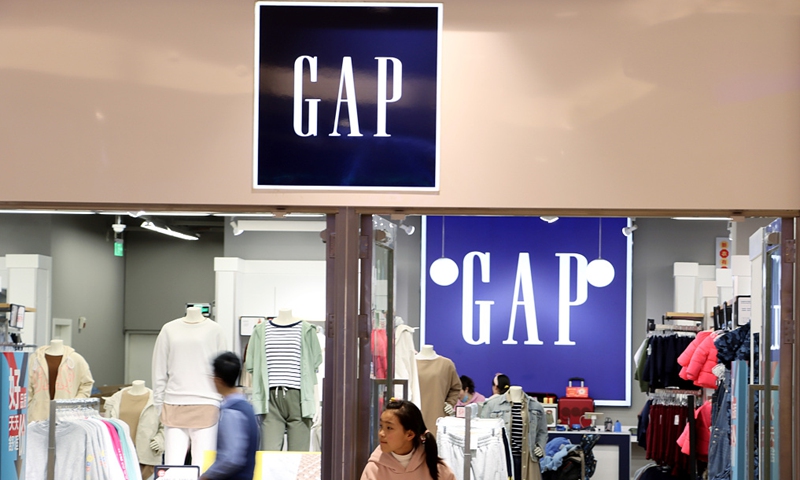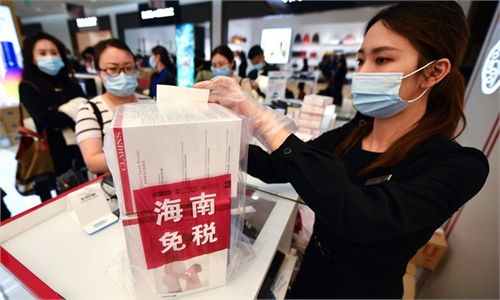Gap revenue declines for 8 consecutive years, missing fast-growing market in China

A Gap store in East China's Jiangsu Province Photo: VCG
As China's consumption market gradually revived from the epidemic, few customers were seen in Gap's store. Compared with other brands with the same positioning like H&M and Zara, US fast fashion brand Gap entered the Chinese market late, without fast development and proper store strategy.
Gap Inc, the US apparel retailer, is weighing options including a possible sale of its China business, seeking to revive its business in the world's second-largest economy, Bloomberg reported on Tuesday.
According to people familiar with the matter, Gap is working with a consultant to explore its options and has reached out to potential suitors to gauge interest in the business. The discussions are at an early stage and the company could decide to continue operations.
"We are not commenting on rumors," a spokesperson of Gap Inc Communications responded to the Global Times over the Bloomberg report on Tuesday.
Netizens have commented on the news on Sina Weibo saying that the quality of the clothes is poor but the price is expensive.
"Ten thousand years of the same style, the price getting more and more expensive every year, I'd be surprised if the company doesn't go bankrupt," wrote Weibo user Song Xiaochuang.
But a Beijing resident surnamed Wang told the Global Times on Tuesday that clothes of Gap are comfortable and the big size is very friendly to oversized people like her compared with other brands, like Japanese brand Uniqlo.
She added that the prices of Gap clothes are acceptable and are similar to other fast fashion brands.
It is worth noting that Gap (Shanghai) Commercial Co, Gap's China business, currently has been the subject of multiple administrative punishment notifications, mostly "production and sales of substandard products posing as qualified products," as showed on corporate information platform Tianyancha.
Gap entered Chinese mainland in 2010 and currently has about 200 stores. While its competitors, H&M and Zara, which entered Chinese mainland five years earlier, on average have 500 to 600 stores. Japanese brand UNIQLO, which has entered the Chinese market as early as 2002, has nearly 800 stores in China.
In march 2020, Gap's sub-brand Old Navy was split from the company and left Chinese mainland, saying it will focus on North America to maximize gains as it is facing a profit decrease.
"Many international fashion brands have encountered various problems after entering the Chinese market, and some have been withdrawing from China. In fact, the phenomenon is an inevitable trend of the hierarchical development of consumption. Meanwhile, the product line, business line and cash flow of companies have not yet made a good adjustment in response to market changes," a market observer surnamed Wang based in Beijing, told the Global Times.
The US remains the company's largest market, while revenue from Asia continues to shrink, accounting for about 5 percent of the total, data showed.
Gap Inc's sales for the full fiscal year of 2020 were $13.8 billion, down 15.7 percent year-on-year, with a net loss of $665 million, according to Gap's financial results released on Thursday.
Net sales at the Gap brand fell 26.8 percent to $3.39 billion in 2020. However, this is the eighth consecutive year of decline for the brand, which has seen revenue nearly halve from $6.35 billion in 2013.
The company said that the Gap Brand's global footprint was meaningfully impacted by COVID-mandated store closures and restrictions in Canada, China, Europe and Japan. North America comparable sales were positive in the fourth quarter.
"We faced one of the most difficult years in our company's history. We are focused on executing against our Power Plan 2023 and delivering profitable growth in 2021," said Sonia Syngal, CEO of Gap Inc during the Q4 2020 earnings call on Thursday.
According to the plan, Gap will focus on Athleta and Old Navy, opening 30 to 40 Old Navy and 20 to 30 Athleta stores this year, and it plans to shrink 30 percent of its Gap and Banana Republic North American stores, which will affect about 350 locations.
Global Times



